Resonances
Braces and bitumen have been applied to reduce resonances. During later stages in the design, where the filter became more correct, some acoustical resonances became obvious. Certain notes were louder than other notes (e.g. obvious with for instance this track of the CD "Road to the Sun" of Sharon Isbin, where the second louder higher pitch G# note sounds much louder than the other notes), hinting at reflections and cabinet resonances.A hint at resonances is obvious from the acoustical waterfall diagrams measurements of the units inside the cabinet. The woofer measurements shows a clear resonance around 468Hz, that hardly decays in the first 10ms.
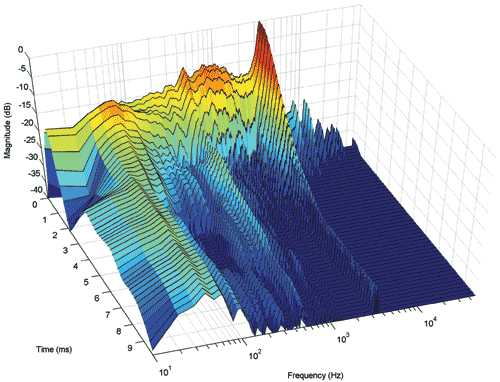
The same holds for the midrange units:
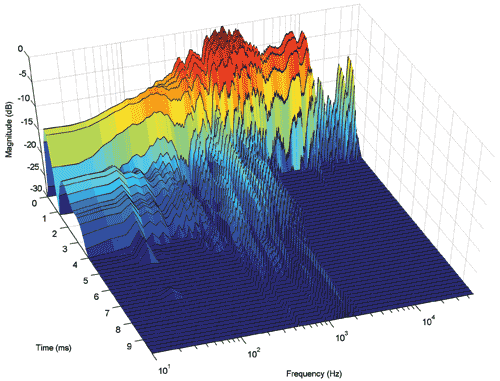
This page tries to find the cause for these resonances, to see whether they can be suppressed. For this purpose, 3 type of measurements can be done:
A. Acoustical measurements. Near-field measurements will show unit effects and internal cabinet resonances. Far-field measurements will also show baffle diffractions (which are no resonances), baffle resonances and room acoustics.
B. Impedance measurements. Impedance measurements show where the units get an "acoustical push" from the environment, visualized by small peaks in the impedance curves. Often caused by internal cabinet resonances, but also by break-ups of the units.
C. Vibration measurements. Usefull to detect vibrations of surfaces, e.g. baffle resonances, grills etc. To measure vibrations, an accelerometer can be used. One should realize that the measurements performed with an accelerometer are no acoustic measurements, and they cannot be directly be translated into "sound", as not each surface translates vibration into sound as efficiently. It however gives me the possibility to distinguish resonances caused by reflections and surface vibrations.
Source of resonances
I see a couple of potential causes of resonances:- Internal cabinet reflections (standing waves).
- The metal grill in front of the units.
- The unit itself.
- Panel resonances (resonating wood).
- Unit-baffle coupling.
- Room acoustics.
I tried to look at all these aspects with a couple of measurements. There are some interesting observations to be made...
Internal cabinet reflections
There are two ways to limit the effect of standing waves:- Add dampening material to absorb acoustical energy and transfer it into heat. Inside the milestones, pritex has been applied in a first stage and sheep wool has been applied in a later stage in the compartment at the back of the woofer. See the filling stage for details.
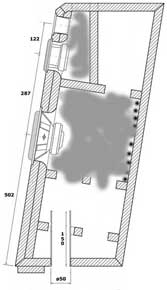

- Irregularities inside the cabinet to diffract the waves, and spread the acoustical waves of the reflected waves in both place and time. This only makes sense for smaller wave lengths, e.g. a wave at 344Hz has a wave length of 1m, and irregularities of a few cm won't cause much diffraction. Inside the Milestones cabinet, braces, edged baffles, and pritex are present to cause irregularities.
For the woofer, I expect the most dominant resonances caused by reflections drawn by solid lines (the sound waves are not so narrow of course). The most dominant will be the black line (about 36 cm, corresponding to an expected resonance in the neighborhood of 477Hz), and the blue line(s) (about 62 cm, hence 277Hz).
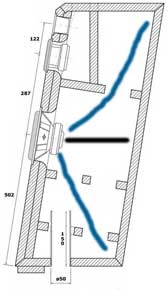
When observing the measured impedance of the woofer, one can see peaks at 274Hz (63cm, the blue line to the top and bottom of the encosure), a small peak at 402 (not obvious from internal cabinet reflections, but as will become apparent later caused by the unit grill resonances), and 478Hz (36cm, the black line back wall).
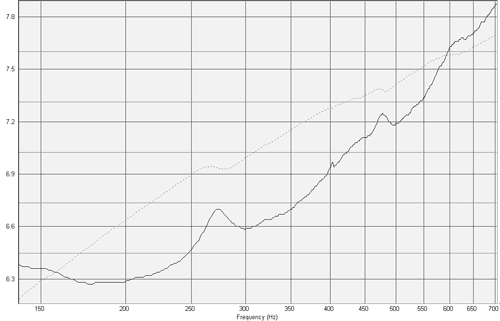
From this measurement I conclude to add more dampening in the upper and lower parts of the cabinet, and apply some more dampening at the back of the woofer.
When observing the measured acoustic anechoic measurement, one can also recognize the resonance at 468Hz (determined from the magnified view), corresponding to the reflection against the back wall. The reflection at 274 Hz is less visible.
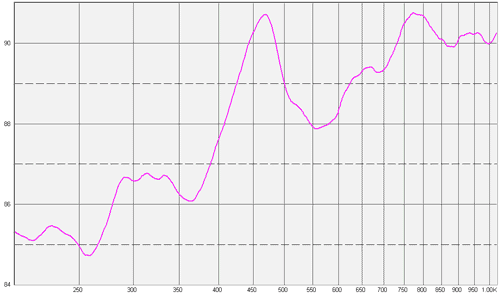
When observing the waterfall, one expects the resonance at 277 Hz to appear after one period (3.6 ms - 1/277), which matches point (1) in the waterfall curve. One expect the resonance at 477Hz to appear after 2.1 ms, but this is not very clear form the figure, as more seems to go one. The waterfall also shows some anomalies at 150 - 200Hz (reflection distance of 86 cm - 114 cm ), which must be reflections as well as they start after one period (about 6 ms) as well. This is a bit peculiar, as there is no such internal length inside the cabinet (a side-effect of the sliding window over the impulse response???). The resonance at 3.5 kHz is a unit breakup resonance.
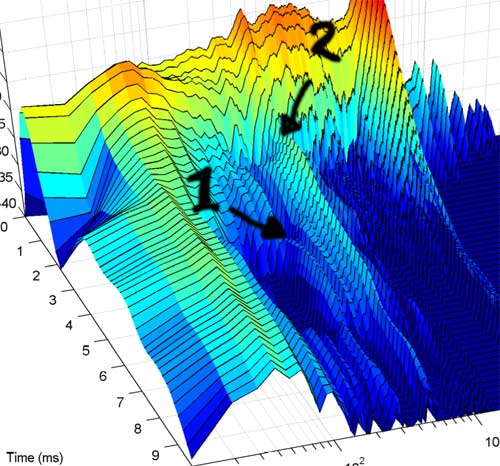
This leaves the large starting peak around 450Hz, which cannot be explained by internal cabinet reflections.
Similarly for the midrange unit. The impedance curve shows peaks at 445 Hz (39 cm, no matching reflective distance, see the unit grill measurements), at 577 Hz (30 cm, which might be the upper distant corner) and 816 Hz (probably a unit property, because this is measured by others in other situations as well). The cabinet of the midrange unit contains quite some dampening, and this seems to work well. The back panel at about 18cm distance (955Hz) doesn't show a peak in the impedance curve.
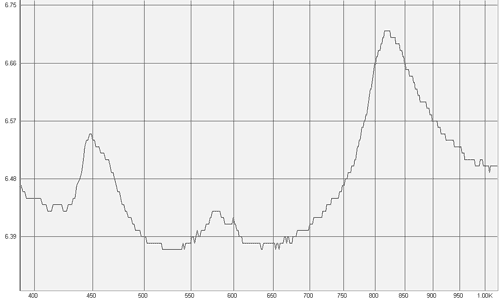
The acoustic anechoic curve shows peaks at 430 Hz, 580 Hz, and 900Hz, and a strong dip at 765 Hz, but there seems to be hardly a correspondence to the impedance curve. The acoustic phase also shows a peak around 800Hz, again hinting at a driver property.

The waterfall shows a reflection at (3), roughly at 950Hz, and starting at about 1ms. The origin of (4), (5) and (6) cannot be explained from internal cabinet reflections.
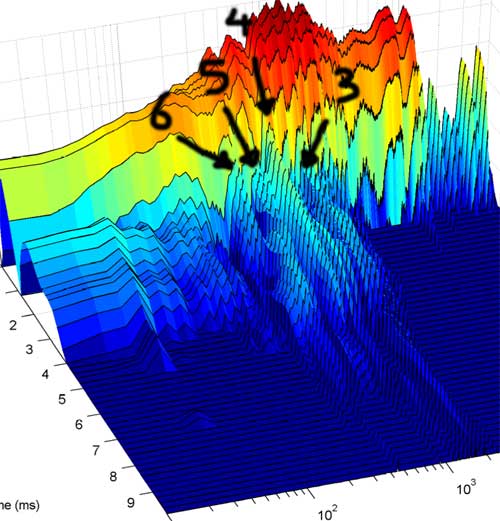
Metal grills
Initially, I performed a sweep with the woofer connected to the filter only. Attaching the accelerometer to the middle of the grill of the woofer, clearly shows a nasty resonance at say 380Hz (I'd like to stress again that these are not acoustic measurements!):
When zoomed in, the internal cabinet reflection is also clearly visible the first 80ms, but quickly decays thereafter:
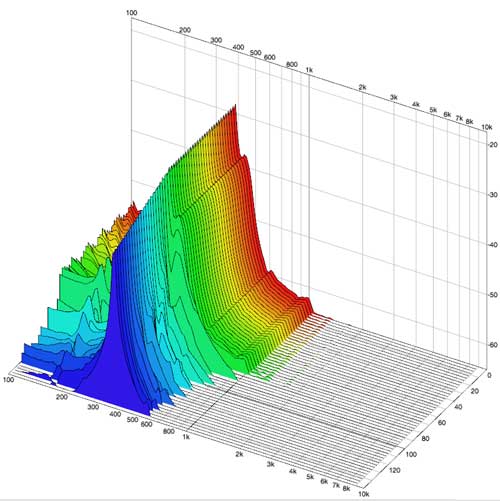
As I suspect a resonance of the grill, I firmly pressed my hand on the grill, and measured the following response. One can see the frequency shifts a bit, and the resonance energy decays much faster.
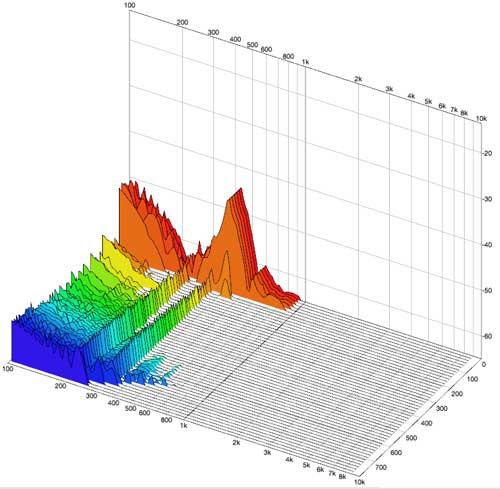
Another interesting measurement of the woofer grill, is one where a heavy object (a copper foil inductor) is held against the grill. One can see that the start of the resonance is more fierce, but it decays very fast because of the weight of the object:
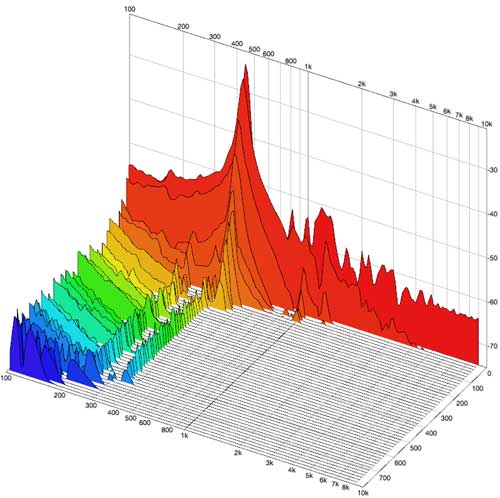
I also measured the woofer in isolation, to exclude cabinet effects. I moved the Milestones speaker on its back, and checked the consistency of the measurements by re-attaching the accelerometer, and measure again. The only difference is that the 190Hz component disappears, matching the internal height of the Milestones cabinet. This will be discussed later, where extensive cabinet measurements are presented.

The measurement of the woofer outside the Milestones cabinet looks as follows. Two things become obvious. The resonance is not caused by some cabinet matter. Furthermore, the mass of the cabinet has a positive effect, because inside the cabinet the resonance of the grill is attenuated faster.
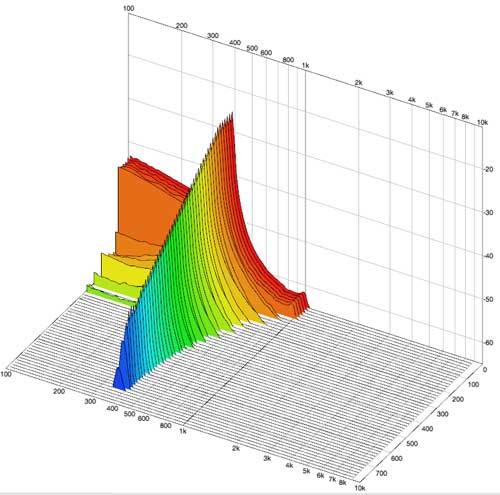
To really be sure the resonance is caused by the grill, and not some weird property of the drive system of the woofer, I attached the accelerator very very very very carefully to the back of the fragile conus of the woofer. The measurement looks as follows:
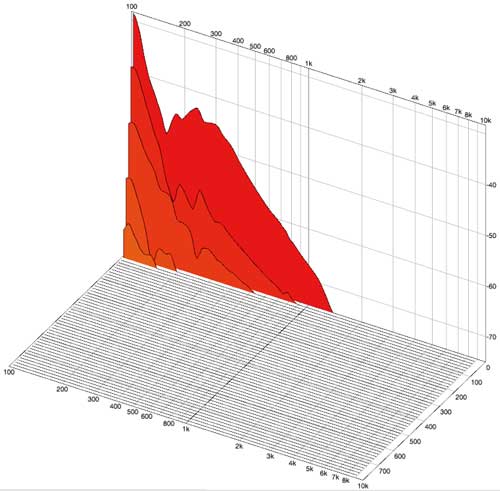
There are no resonances, visible, so the previous measured resonances are definitely from the grill! Normally I would remove the grill immediately, but the brittle conus material of these expensive units are not compatible with the hands of children that are present in our house so now and then.
Or zoomed in a bit, and for a broader range (forget about the 50Hz hum. One can see that the resonance of the woofer is higher due to the added weight of the accelerator to the woofer conus.
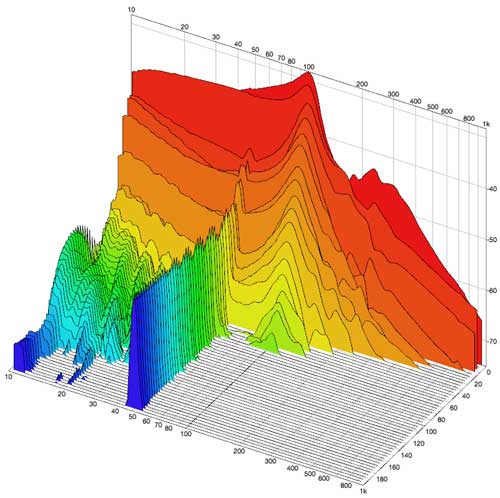
To give an impression of how the grills sound, I've made a recording of the sound of a grill (with the internal speaker of my laptop, so noisy), by striking it with the rubber back of a hammer. The first sound is the woofer grill, the second sound is the midrange grill. The sound file gives an impression of the decay and the timbre of the grill. I've performed an FFT to these sound, and respectively these look as follows. They clearly show the frequency components, and additionally some components due to the beating.
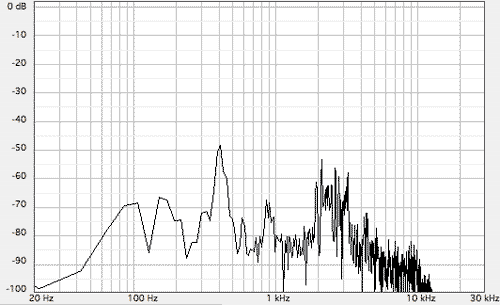
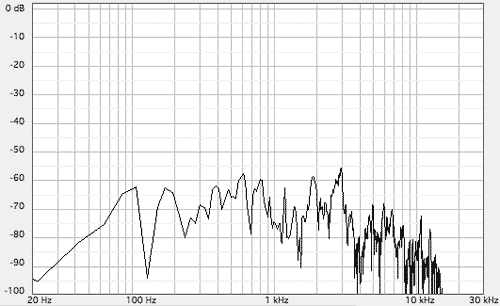
Panel resonances
I've measured the panel resonances at various places, using a sweep from 20-20.000 Hz with all units active. An overview of the measurement points is given in the following figure.
An overview of the different measurement points (100ms length):
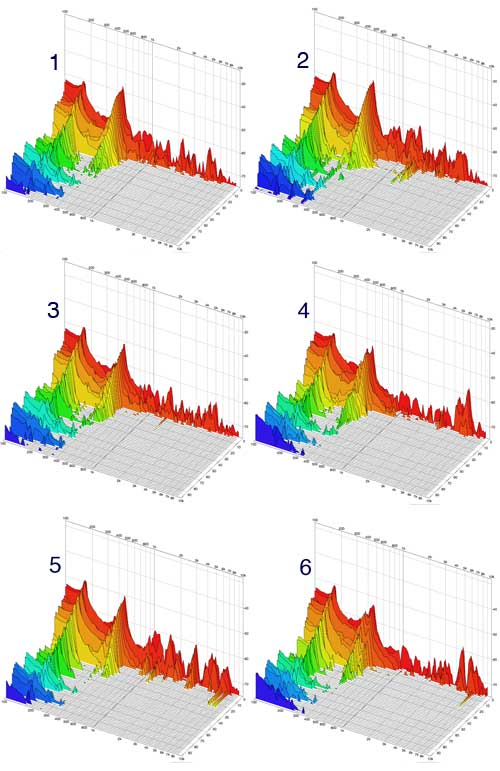
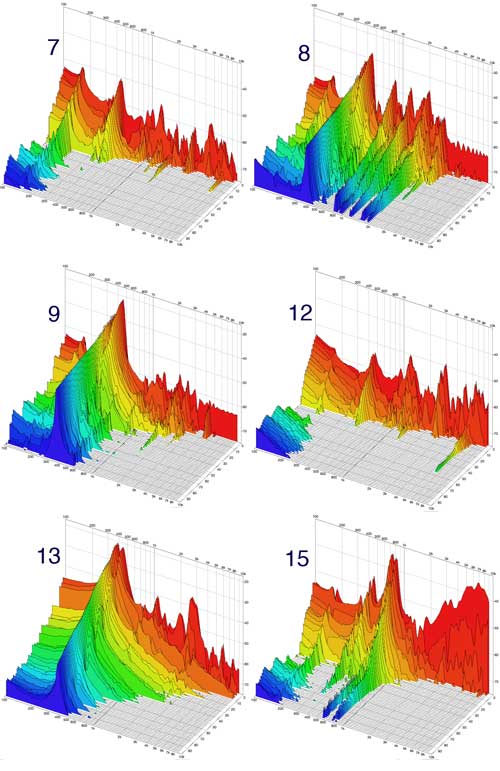
Measurements on the side, and on the top (21):
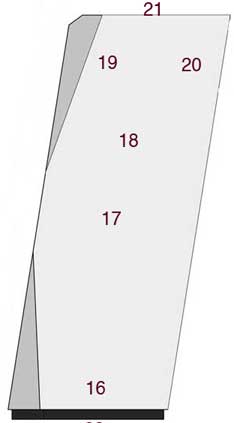
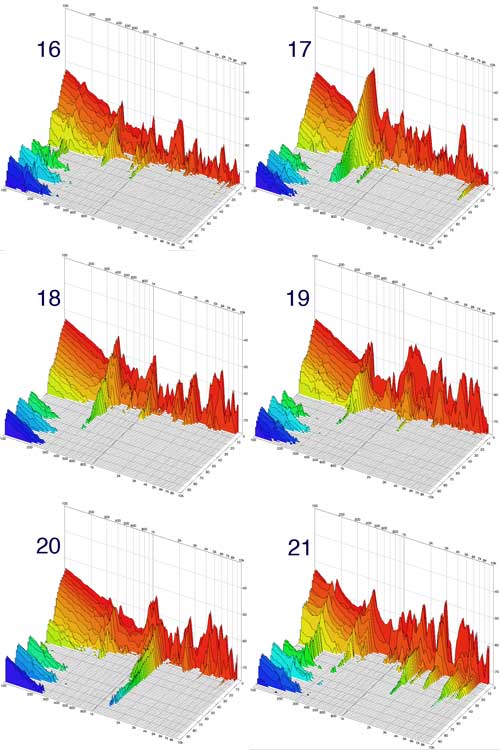
For the backside, we see he following:

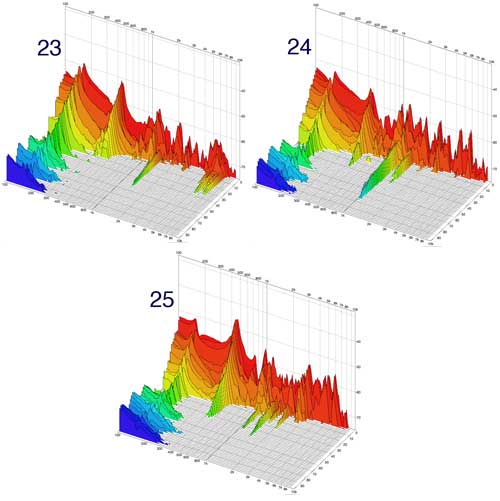
As can be seen, there is a strong 190Hz component, that is dampened when the cabinet lies on its back. 190 Hz correlates to a standing wave in the height of the speaker. In the middle of the cabinet, a brace has been applied to support the magnet of the woofer:
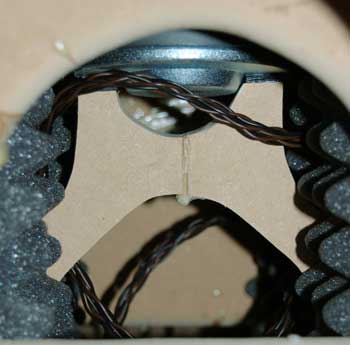
As can be seen, this brace consists of 2 segments, and has been glued. Due to the pressure of the woofer magnet, the brace has some friction, and I can imagine this causes vibrations. I've therefore removed some bitumen parts that connect the woofer to the brace, and the audible resonances at that point disappeared, but the bass seemed to become somewhat "thin".
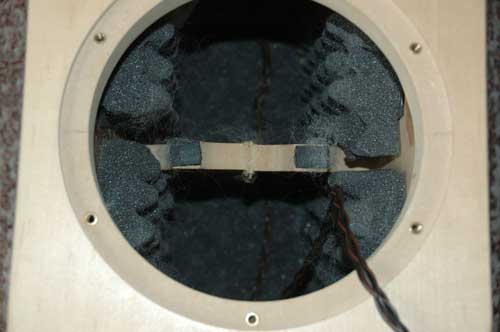
In a later stage, I replaced the bitumen with some felt, that gives a smooth connection. The audible resonances re-appeared, and the bass seemed full again, but I suspect the harmonics give the idea of more bass. I decided to remove the contact permanently, and increase the woofer output a bit, which overall gave a full resonance free sound.

Unit-baffle coupling
Does a baffle resonance decay faster when a woofer is strongly coupled to a cabinet? I've compared three situations, one where the woofer is directly and tightly coupled to the cabinet, one where it is directly but loosely coupled, and one case where the woofer is coupled with a rubber ring ("krimpkous"). I've measured the baffle directly underneath the woofer. The waterfall curves are as follows:Woofer loosely coupled. As there is hardly a solid connection to the heavy cabinet, the grill resonance is not transported to the baffle.
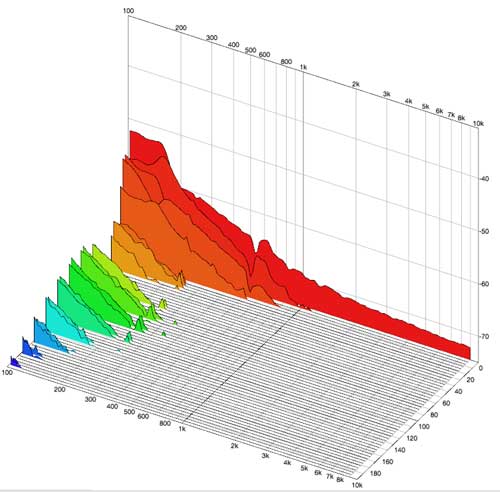
In case the woofer is tightly coupled, the grill resonances are also transfered to the cabinet. As shown in the grill measurements of the woofer, the cabinet has an attenuating effect to this resonance when coupled to the cabinet.

In case a rubber ring is applied, the following situation occurs. The resonance frequency becomes lower, and the baffle resonance though a bit lower in magnitude, becomes longer. This means that the woofer grill is resonating for a longer time, because it is less dampened by the mass of the enclosure. Hence, it seems to be a good idea to make a tight coupling.

But... On the other hand, a tight coupling is also capable of absorbing energy. And I was quite amazed when measuring the grill of the woofer, when only the midrange units was connected to the filter (so the accelerator is on the woofer grill, and only the midrange is sweeping). This is even worse than the playing the woofer itself (the mid has > 15dB more acoustic output at this range). I guess another phenomena is that the electrically disconnected woofer is not dampened well, and the energy spreads out, and slowly moves to the resonance frequency of the woofer.
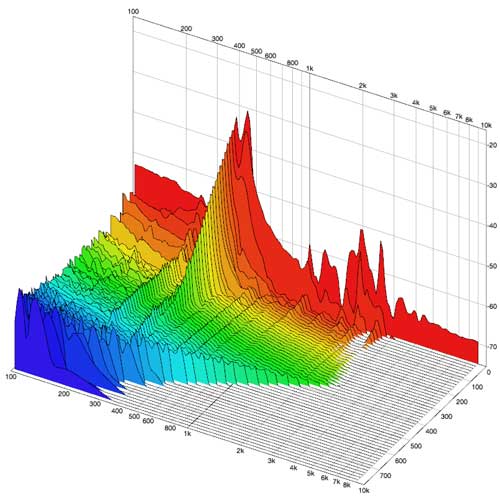
I cross-checked by playing both the woofer and midrange as in the 2nd-order filter (where they are in anti-phase), and also where both the midrange and woofer are put in-phase. The filter case:
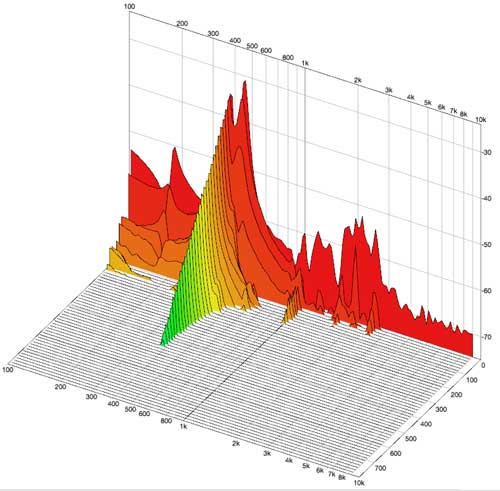
The case where both units are connected in the same phase:
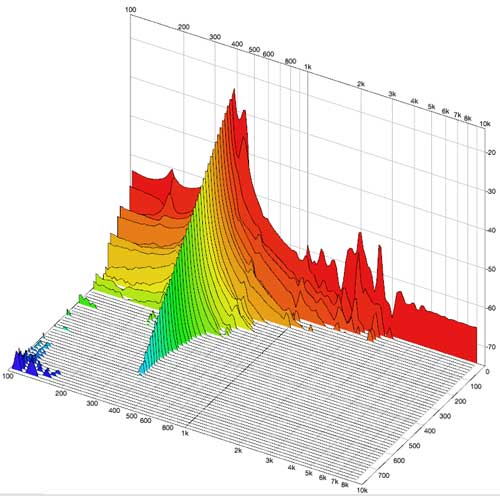
For completeness, the normally filtered situation of the units, but measured on the grill of the midrange:
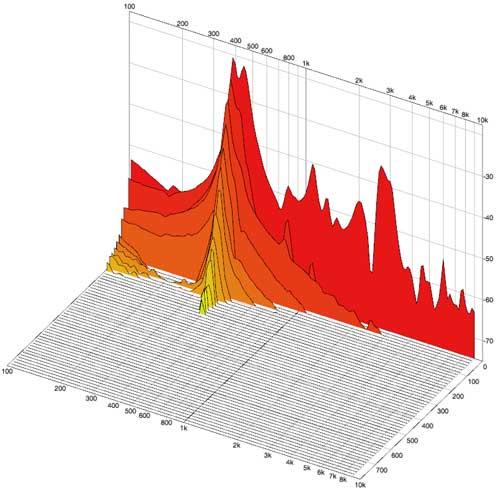
Again, this hints at removing the grills as already concluded previously. Furthermore, a fixed connection to the baffle means more interaction between the units. Instead of using rubber rings, which slow down resonance reduction, these measurements hint at putting the units in a different enclosures to decrease vibration reduction.
Room acoustics
With no specific measurements done, I only mention that the audible resonance seems to be more fierce at the current listening position and set-up.Unit itself
The units themselves also have resonances, as mentioned before. The woofer has a significant one at 3.4 kHz, but this is outside its operating range, and there are no signs of resonances in that area. The midrange has a dip around 780Hz, which I heard are caused by the black parts in the conus to dampen resonances further on. Not so much can be done about the resonances, so I leave them for what they are.Conclusions
I had great fun doing these measurements, and I think they are very revealing.As the measurements tell something about vibrations, and not about the transformation of these vibrations into sound, it is hard to draw absolute conclusions about the significance of some of these resonances. For me, they give an indication of the cause of some resonances that we measure in the acoustic waterfall diagram. In the acoustic waterfall most of the resonances are dampened more than 30dB within 10 ms, so my suspicion is that the effect will be audible, but not very dominant.
I'm very happy there are grills on the Thiel units to protect the brittle conus, but the amount of vibrations they cause is quite fierce. I would recommend Thiel to think of some optimizations in their future products regarding these grills.
The cabinet enclosure seems to be well constructed. There is one vibration dominant at the back-side at 190Hz, of which half the wave length (90 cm) corresponds to the internal height of the enclosure. I'll discuss with Gydotron if he can think of a place where this resonance can be lowered with some new internal brace, he always comes up with good ideas regarding constructions. The corner pieces seem to vibrate only a little bit more than the front baffle, and I consider them well-designed.
I will add some more dampening in the top and bottom of the cabinet, which I expect will attenuate some internal cabinet resonances at 190 and 274Hz.
Interesting links
- Linkwitz info on mounting a driver to a baffle.- Dicussion in zelfbouwaudio about this topic (Dutch)
- Topic of Jeroen to influence mechanic resonances (Dutch).
- Measurement of different materials, the links are mentioned on the wooden stage page.
next ->